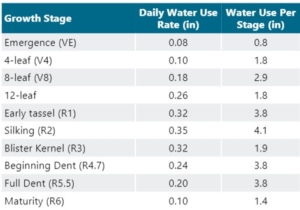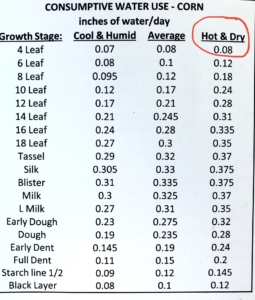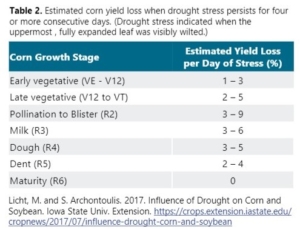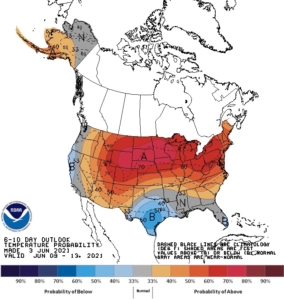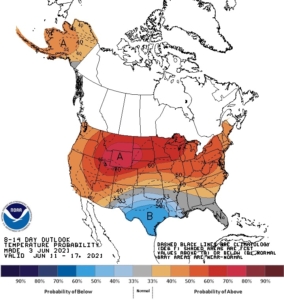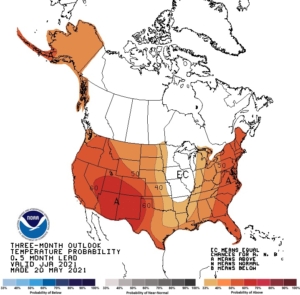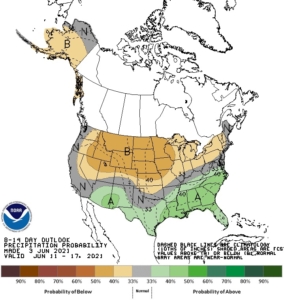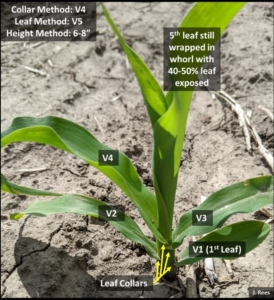
Fun Fact: It takes 91 gallons of water to produce one pound of corn….that’s roughly 5,000 gallons per bushel!
TOPICS FOR THIS UPDATE:
- Temperatures/Precipitation & GDU accumulation
- What’s going on in my fields right now….
- Disease Update & Fungicides….
- Insect Update
- Soybean Update
TEMPERATURES/PRECIPITATION & GDU ACCUMULATION:
As of June 29th, we have accumulated approximately the following for Growing Degree Units in 2021:
Planting Date GDD’s2021 Average GDD Departure from average
April 24 1075 932 + 157 (+ 6 days)
April 30 1021 887 +134 (+5 day)
May 6 924 833 +91 (+3.5 days)
As to be expected with the hot temperatures we experienced in the first half of the month, June was above normal for GDU accumulation. We accumulated approximately 600+ GDU’s for the month and we are currently 4-6 days ahead of average and of last year. Let’s look further at future temperature and precipitation forecasts…..
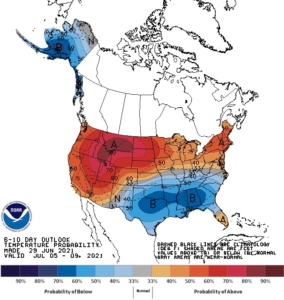
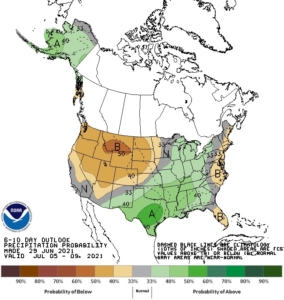
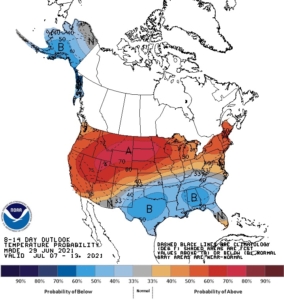
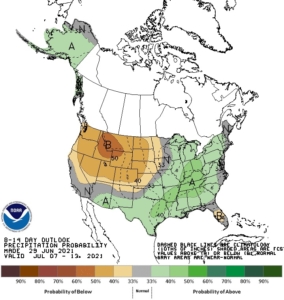
We see that the 6-10 day and 8-14 day maps are forecasting an above normal temperature and below normal precipitation pattern for much of the western cornbelt through the first half or more of July. This pattern is very similar to what we experienced in the first half of June. This will spur rapid elongation by the plant, and if forecasts turn out as predicted, we will continue to trend normal to slightly above normal for GDU accumulation through this period. We will also an see increased potential for moisture stress this year versus the past few years if this proves out to be true.
What’s Going On In My Fields Right Now?….and What’s Next?….
- Much of the corn crop is in the 10-12 leaf stage right now.
- At this stage, the tassel is beginning to develop rapidly now and the stalk is continuing rapid elongation. At present, it appears that plant height will be on the tall side….
- Stalk elongation occurs through the elongation of its internodes. Next few weeks will see peak susceptibility to green snap….
- By V10, the time between the appearance of new leaf stages will shorten, generally occurring every two or three days…or approximately a leaf for every 50 GDU’s.
- In the above forecasts, we will be accumulating 25-28 GDU’s/day, so expect a new leaf potentially every couple of days.
- At V10, the corn plant begins a rapid, steady increase in nutrient and dry weight accumulation which will continue far into the reproductive stages.
- Soil nutrients and water are now in greater demand to meet the needs of this increased growth rate. Keep this in mind as you think about your total N applied so far and what future needs will be….and keep in mind a post-pollination application in your N plans….
- Kernels per row begin around V12 and continue through and up to tassel stage….’just around the corner’….
- Overall color and N efficiency has been excellent so far this year, especially on sandier soils…..one benefit from the dry conditions. There has been limited N leaching, while N mineralization has the potential to be higher this year if temperatures stay on the warm side.
- Greatest yield loss from moisture stress occurs from two weeks prior to, to two weeks after tassel. With current weather conditions and forecasts, the great majority of the crop will most likely be tasseling the week of July 13th. This will depend upon hybrid and planting date of course. GDU’s to silk run from 1280 – 1450 depending upon hybrid. If forecasts turn out to be true, GDU accumulation over the next two weeks will be approximately 360-400 GDU’s….add this to 1000 and we will reach 1300-1400 GDU’s by July 15th…..In other words we should start to see tassels in 10-18 days depending upon hybrid and planting date. Bottom line, water needs will be greatest over the next month and into early August.
- ET rates in corn have been dramatically lower for the past 14 days versus the first 14 days of June. From June 15-29th, ET rates have averaged .23″/day, down substantially from the .37″ in the first two weeks of June. This, coupled with nice rainfall amounts for most of the area, has given us a good soil moisture profile in the top two feet heading into peak water use at pollination. With the above forecasts for heat and dry conditions, expect ET rates to be .30-.40+”/day heading into and through pollination….potentially 2-3″ per week of ET usage. You want to maintain this current soil moisture profile heading into pollination.
- We are seeing a little leaf scorch on the tough sand knobs from the heat in the first 14 days of June. This will be a concern at pollination as well if hot temperatures and low relative humidity is present.
- The main nodal root system is developing with the last (5th) nodal root developing quickly now. Brace roots will develop over the next couple of weeks.
- Waterhemp and Palmer Amaranth control continues to be a constant battle….and sometimes I think the weeds win!….I know cultivating is a four-letter word, but it still has its place as the below picture attests to….
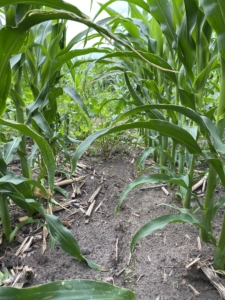
The grower lifted his cultivator up as he passed over his pivot road….the difference was dramatic between what was cultivated and what was not.
DISEASE UPDATE & FUNGICIDES….CORN & SOYBEANS….
- Leaf disease pressure, in corn and soybeans both, is very low at the present time. For instance, Bacterial Leaf Streak is at as low an incidence as I can remember for the past few years. This is one benefit from hot, dry weather! However, due to the cooler and wetter conditions of the last 10 days or so, we expect to see an increase in overall leaf disease. However, if conditions once again turn hot and dry, this will slow overall disease development.
- We have seen good responses to fungicide applications in both corn and soybeans over the past few years, and we recommend a fungicide application on both crops. Timing is best for corn right after pollination….7 days after you see the corn field fully tassled, pollination is pretty well complete. This is when the plant is working the hardest, so this is when you want the most protection. Soybean applications depend upon whether you are controlling for white mold or not. Any fungicide application for white mold should be on, or going on, this week. To get best results on controlling white mold, one needs to treat at R1 (Beg. flower) for sure. Most soybean fields are at R1 or late-R1, early R2. If not controlling for white mold, the best timing is at R3, or pod set. If spraying for white mold, Aproach and Delaro give the best protection!
- Considering how tight all products seem to be this year, we recommend you lining up your fungicide and insecticide needs early.
INSECT UPDATE….
- We are currently finding 2-8% European Corn Borer larvae infestations in popcorn. Keep an eye out on your popcorn and conventional corn acres for this pest. We are getting good results from treating. See video link….https://youtu.be/I90RD6wiP6o
- Plan on scouting just prior to tasseling for Western Bean Cutworm, start checking next week. We will have pheromone traps out once again to monitor flight activity. Check back on our website for updated counts.
- So far very little insect activity in soybeans. Thistle caterpillars are non-existent this year.
- Starting to see small grasshoppers show up in corn and soybeans. Keep an eye out for this pest due to the dry, hot conditions.
- Corn rootworm larvae are in the 3rd instar stage to pupating at present. Begin scouting for adults as tassels and silks begin to show up to protect from any silk-clipping interfering with pollination and to help determine timing of adult beetle control for next year on the corn-on-corn acre.
SOYBEAN UPDATE
- Soybeans are currently in the R1 (Beg. flower) to late-R1 stage.
- They are finally starting to have some good growth with the cooler conditions of the past 10 days or so. Soybeans do not like it hot.
- As we have the past few years, we continue to see leaf-cupping in area fields. Most fields are starting come out of this, but a few are still showing heavy cupping.
- With the wet and cooler conditions of the past 10 days, we are starting to see some iron chlorosis (yellow to pale green areas) start to appear on the high pH hillsides in area fields. This comes on when conditions turn wetter and cooler. See link for more info….good description under the weather heading….https://corteva.showpad.biz/webapp2/results?query=iron%20chlorosis&scope=content&slug=27b46d1f-0a85-451e-834f-0f1c482b0899
25 Years and counting….
- Starman Seed Service, Inc. is celebrating their 25th anniversary in business in 2021!
- ‘Save the date’…our annual customer appreciation supper is scheduled for Friday, August 20th.
- More info to follow at a later date…..
Thanks for your business and thanks for all of your support over these past 25 years!!!
Starman Seed Service, Inc.

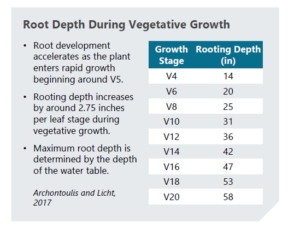 We are currently at 7-9 leaf corn depending upon planting date, tillage and other factors. From the chart, you can see that average rooting depth for V8 corn is approximately 20-25″, depending upon weather conditions, soil type and structure, etc., however, the corn crop should be rooted from 16-24″ at present going off of stage-of-growth. We will show in the video below what the average root depth is for our crop from what the AquaSpy moisture probes are showing…
We are currently at 7-9 leaf corn depending upon planting date, tillage and other factors. From the chart, you can see that average rooting depth for V8 corn is approximately 20-25″, depending upon weather conditions, soil type and structure, etc., however, the corn crop should be rooted from 16-24″ at present going off of stage-of-growth. We will show in the video below what the average root depth is for our crop from what the AquaSpy moisture probes are showing…